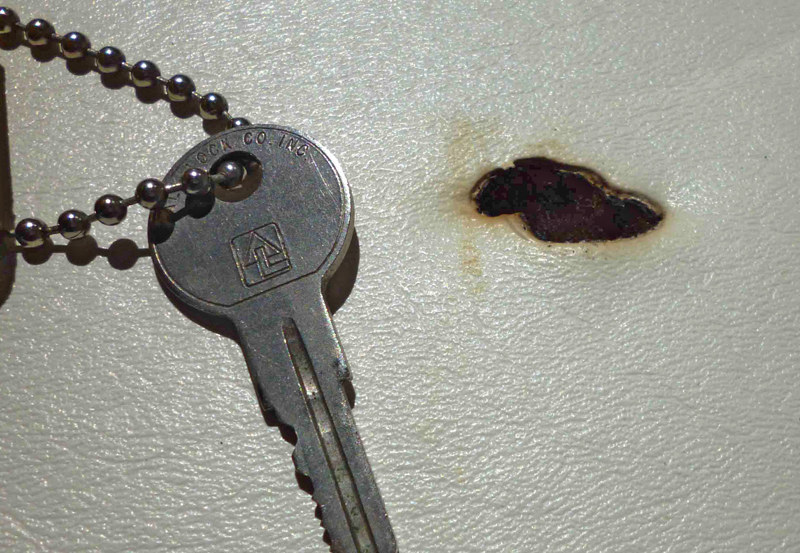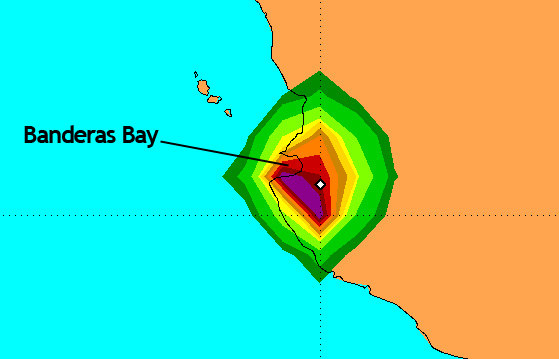
Photo Contest of the Day
If onboard fires aren’t every boater’s biggest fear, they probably should be. Fiberglass boats are made up primarily of accelerant so once a fire starts, it’s frighteningly tough to put out. Boaters go to great lengths to prevent conflagrations, from installing smoke detectors to automatic flame suppression systems. But not all fires start in the belly of the boat — some can start topsides, where you’d least expect it.

For example, this dime-sized burn mark in a vinyl cockpit cushion came from a very surprising source. Can you guess what it was? The first correct answer wins a Latitude 38 hat! Send your answers to LaDonna and look for the full story in Friday’s ‘Lectronic.
Update: We have a winner, so no need to send in your guess. Thanks to everyone who played and be sure to check back on Friday to find out what really caused that burn mark.
Quantum Leap Abandoned
Longtime sailors Bill Finkelstein and Mary Mack of the Santa Rosa-based Valiant 50 Raptor Dance were a little embarassed to tell us they were making a passage to Hawaii, not aboard a sailboat but aboard a cruise ship. Ironically, one of the most exciting moments of the crossing came last October 6 when their ship, 815-ft Celebrity Century, was diverted to rescue the crew of the 48-ft aluminum sailboat Quantum Leap 600 miles from landfall.
"The master of the Celebrity Century did a fantastic job piloting the ship to windward of the crippled sailboat," reported Bill, "while the safety officer piloted a tender to effect the transfer." The sailboat’s injured captain, Phillip Johnson, 62, of Washington state, was stabilized aboard the 1,800-passenger vessel by the ship’s medical staff. After being transfered upon arrival at Hawaii to Hilo Medical Center, it was learned that he’d suffered five broken vertebrae and a cracked rib when his boat was "hit from the side by a wave," which hurled Johnson across the cabin in the galley. His two crewmen were uninjured, but the boat suffered serious damage, including loss of power.
It should be noted that this offshore rescue was substantially expedited because Johnson had a satellite phone on board, which he used to give Coast Guard personnel in Hawaii the exact coordinates of his vessel, while alerting them to the complete details of his emergency. Mariners en route to Hawaii should be aware Quantum Leap was abandoned, and is presumed to be adrift heading west with prevailing winds and currents.
Sailors’ Chance to Comment on A-Cup
What will perhaps be the only opportunity for the Bay’s sailing and recreational boating community to actually get on record over how the America’s Cup will affect us is coming up tonight. The Coast Guard will be hosting a public meeting to field comments on the impacts of America’s Cup at Gresham Hall on Coast Guard Island in Alameda from 6-8 p.m. They’re encouraging anyone to come, so bring friends and be sure to have a government-issued ID handy as they’re required to get in.
We would have liked to have given you this information earlier but, much in the same way that the official Fleet Week press release wasn’t issued until the 11th hour, the same happened with this one — it apparently went out yesterday. The only difference is that the Coast Guard never sent this one to us — we didn’t get it until someone from the PICYA forwarded it on. One thing is for sure: having such little lead time means a lot fewer sailors will be able to be involved.

Just a reminder that, as we noted last week, the AC 45s will be doing some "testing" — i.e., sailing — this week, so if you get a chance to get out on the Bay over the next few days, be sure to take your camera with you.
Jova a Non-Event in Banderas Bay
Here’s something you’re not likely to see again anytime soon — a hurricane/slash tropical storm passing to the east of Puerto Vallarta. In other words, inland of the coastal city.

Yet that’s exactly what happened early this morning, as Category 2 Hurricane Jova made landfall at Chemela on the Gold Coast with 100-knot winds, then headed NNE across the tall jungle-covered mountains on a path that would take her just 15 miles to the east of the city of 250,000. Boating interests had been justifiably concerned, as forecasts included the possibility that Jova might make a direct hit on Banderas Bay, or at least blast it with 50+-knots winds. Banderas Bay is home to four marinas and hundreds of sailboats.
At 10:30 this morning, Doña de Mallorca, who had rushed from the States to Vallarta by plane and by bus from Guadalajara to oversee the waterfront condos she rents at Punta Mita, reported there had only been a little rainfall and the winds were less than 10 knots out at the tip of the bay. By this time Jova was directly to the east, the least destructive side of a northern hemisphere tropical storm, so there were lots of smiles all around.
©2011 Latitude 38 Media, LLC
Some video of the surf smacking up against the waterfront restaurants at Barra de Navidad, to the south of where Jova made landfall, was posted on YouTube. At the time, it didn’t look too bad, so we haven’t bothered including it. Our best wishes to those nearer ground zero of Jova‘s landfall, meaning Chemela, Careyes, Tenacatita Bay. The good news is that in just weeks they’ll all be basking in warm winter sun, with cruising boats anchored just offshore.
